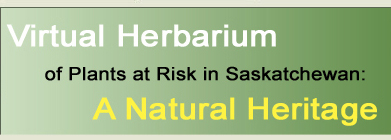
|

|

|

|

|

|

|
|
|
|
|
|
| Danthonia californica Boland. | Species Image Gallery (opens in a new window) |
||||||||||||||||||||||||||
| TAXONOMY | |||||||||||||||||||||||||||
| Family: | Poaceae | ||||||||||||||||||||||||||
| Genus: | Danthonia | ||||||||||||||||||||||||||
| Species Synonyms: | Danthonia americana Scribn. Danthonia californica var. americana (Scribn.) A.S. Hitchc. Danthonia californica var. palousensis St. John Danthonia californica var. piperi St. John |
||||||||||||||||||||||||||
| Common Names: | California oatgrass | ||||||||||||||||||||||||||
| DISTRIBUTION | |||||||||||||||||||||||||||
| Canada: | southern British Columbia – southern Alberta – southwestern Saskatchewan | ||||||||||||||||||||||||||
| Saskatchewan: | southwestern Saskatchewan; Cypress Hills – Swift Current | ||||||||||||||||||||||||||
| Ecoregion: | Cypress Upland, Mixed Grassland | ||||||||||||||||||||||||||
| HABITAT | |||||||||||||||||||||||||||
| Saskatchewan: | open, upland meadow slopes | ||||||||||||||||||||||||||
| Associated Species: | Carex brevior, Dasiphora floribunda, Festuca hallii, Poa secunda, Polygonum polygaloides ssp. confertiflorum, Potentilla gracilis, Zigadenus venenosus | ||||||||||||||||||||||||||
| RARITY STATUS | |||||||||||||||||||||||||||
| Provincial
Status According to Harms (2003): |
Threatened |
||||||||||||||||||||||||||
| Nature Conservancy Status: | G5 S2 |
||||||||||||||||||||||||||
| Saskatchewan
Species at Risk Status: |
None |
||||||||||||||||||||||||||
| COSEWIC Status: | None |
||||||||||||||||||||||||||
| Danthonia californica is threatened because it is rare or uncommon in Saskatchewan. It is somewhat regionally restricted and population sizes vary. Possible threats have been identified for this species. | |||||||||||||||||||||||||||
| SPECIES DESCRIPTION | |||||||||||||||||||||||||||
| Height: | 30 – 90 cm tall | ||||||||||||||||||||||||||
| Roots: | fibrous, rhizomes lacking | ||||||||||||||||||||||||||
| Stems: | caespitose, glabrous, tending to break at the nodes | ||||||||||||||||||||||||||
| Leaves: | 10 – 30 cm long, 1 – 3 mm wide, flat or involute, uppermost leaves strongly divergent to reflexed at maturity, glabrous to sparsely pilose; sheaths glabrous; ligules of hairs | ||||||||||||||||||||||||||
| Inflorescence: | panicle 3 – 8 cm long, racemose; branches slender, erect or spreading, flexible; pedicels on lowest branch longer than spikelets, may be crinkled | ||||||||||||||||||||||||||
| Spikelets: | spikelets 2 – 5, 2 – 2.5 cm long | ||||||||||||||||||||||||||
| Florets: | glumes 1 – 1.5 cm long; callus pilose; lemma 8 – 10 mm long, apical teeth aristate; lemma awn 1.5 – 2 cm long, twisted, geniculate | ||||||||||||||||||||||||||
| Fruits: | caryopsis | ||||||||||||||||||||||||||
| |||||||||||||||||||||||||||